Kenya Certificate of Primary Education 2019 Science
Kenya Certificate of Primary Education
2019 Science
1. Which one of the following pairs of human body parts is used in breathing?
A. Lungs and oesophagus.
B. Nose and trachea.
C. Diaphragm and stomach.
D. lose and oesophagus.
2. Which one of the following waste products is excreted by the lungs?
A. Excess salts.
B. Urine.
C. Sweat.
D. Excess water.
3. Which one of the following pairs of diseases only consists of sexually transmitted infections?
A. Gonorrhoea and malaria.
B. HIV/AIDS and measles.
C. Syphilis and chancroid.
D. Bilharzia and Gonorrhoea.
4. Which one of the following is the third stage of HIV/AIDS infections?
A. Symptomatic.
B. Window.
C. Full blown.
D. Incubation.
5. Which one of the following components of the environment is the main source of energy for living things?
A. Plants.
B. Air.
C. Water.
D. Soil.
6. Which one of the following least pollutes the soil?
A. Excess fertilisers.
B. Oil spillage.
C. Kitchen leftovers.
D. Mining.
7. The soil that cracks easily when dry has
A. a rough texture.
B. small particles.
C. large airspace.
D. low capillarity.
8. The diagram below shows a set-up used to investigate a certain component of soil.
The component of soil that was investigated is
A. living organisms.
B. organic matter.
C. air.
D. water.
9. Which one of the following pairs of types of soil erosion forms V-shaped ditches?
A. Gulley and rill.
B. Sheet and Gulley.
C. Rill $ Splash.
D. Splash and sheet.
10. Which one of the following nutritional deficiency diseases is more likely to be suffered by mothers or newly born babies?
A. Kwashiorko.
B. Marasmus.
C. Anaemia.
D. Rickets.
11. Which one of the following foods is more rich in both proteins and fats‘.
A. Avocado.
B. Milk.
C. Sunflower.
D. Beans.
12. The following produce special sounds, except sound from a?
A. hooting car.
B. fire engine.
C. ringing bell.
D. moving tractor.
13.The diagram below shows a set-up that can be used to investigate heat transfer in a liquid. what should be added to the water for the pupils to observe heat transfer?
A. Salt.
B. Stones.
C. Saw dust.
D. Wax.
14. In which of the following devices is renewable energy used?
A. Battery.
B. Kerosene stove.
C. Burning candle.
D. Charcoal jiko.
15. The following activities were done when it was raining:
(i) walking bare footed on the road
(ii) lying on the bed
(iii) playing football in the field
(iv) driving a car on the road.
In which two activities is one more likely to be struck by lightning?
A.(i) walking bare footed on the road
B.(ii) lying on the bed
C.(iii) playing football in the field
D.(iv) driving a car on the road.
16. Which one of the following sources of electricity pollutes air?
A. Dynamo.
B. Geothermal generator.
C. Biogas driven generator.
D. Solar panel.
17. Which one of the following groups of materials consists only of materials that are magnetic?
A. Bottle top, copper coin, aluminium foil.
B. Razor blade, staple pins. steel wool.
C. Spoon, copper wire, silx’er coin.
D. Nail, aluminium foil, silver coin.
18. The chart below represents a simple classification of liquids.
Which liquids are represented by E and F?
A. Kerosene, Water
B. Water, Milk
C. Cooking oil , Milk
D. Water, Kerosene
19. Which one of the following materials allows light to pass through but one cannot see through?
A. Fluorescent tube.
B. Smoke.
C. Clean water.
D. Mirror.
20. The percentage of the component of air that makes a bulb glow without burning is?
A. 75%
B. 21%
C. 0.03%
D. 0.97%.
21. Which one of the following groups of substances has definite volume and shape?
A. Oxygen, water and ice.
B. Ink. grease, glucose.
C. flour, powdered chalk, salt.
D. Sand, powdered milk, methylated spirit.
22. Which one of the following machines works in the same way as a croat bar?
A. Spade.
B. Claw hammer.
C. Ladder.
D. Wheel barrow.
23.The following machine make work easier by reducing the effort required except
A. crowbar.
B. ramp.
C. flag post.
D. ladder.
24. Which one of the following statements is true about rain water?
A. Uses more soap during washing.
B. Saves time and energy during washing.
C. Is rich in minerals.
D. Stains clothes.
25. A pupil who buys mango fruits from market and eats without washing is likely to be infected with.
A. typhoid and cholera
B. bilharzia and cholera
C. typhoid and malaria
D. bilharzia and malaria.
26.Which of the following practices conserves water by using it sparingly?
A. Treating and using sewage water.
B. Harvesting rain water.
C. Using water used to wash vegetables to water plants.
D. Supplying water once a week.
27. Which of the following groups of activities only consists of industrial uses of water?
A. Fishing, transport, mixing chemicals.
B. Washing vehicles, constructing roads, mixing chemicals.
C. Boat racing, swimming, fishing.
D. Cooling machines, drinking, cleaning of tools.
28. Which one of the following pairs of blood vessels carries deoxygenated blood?
A. Vena cava and aorta.
B. Pulmonary artery and pulmonary vein.
C. Vena cava and pulmonary artery.
D. Pulmonary vein and aorta.
29. Which one of the following features is least important o hen describing a molar tooth‘?
A. Roots.
B. Cusps.
C. Broadness.
D. Hardness.
30. Which one of the following components of blood is correctly matched to its function?
Blood component Function
A. Plasma Transports oxygen.
B. White blood cells heat distribution.
C. Platelets Blood clotting.
D. Red blood cell Transports iron.
31. The following are some effects of drug abuse:
(i) drug induced accidents
(ii) addiction
(iii) coma
(iv) rape
(v) truancy
(vi) impaired judgement.
Which three are classified as health effects?
A. (i) (ii) (iv)
B (iii) (iv), (v).
C. (ii), (iii), (vi).
D. (i), (iii), (iv).
32.The following are some characteristics of a certain vertebrate:
(i) scales on the body
(ii) varying body temperatures
(iii) lay externally fertilised eggs
The animal with the above characteristics is likely to be
A. salamander.
B. shark.
C. lizard.
D. duck.
33. Which one of the following is the main effect of HIV/AIDS on the nation’?
A. Increased medical expenses.
B. Poor health.
C. Stigmatisation.
D. Lack of parental care.
34. Which of the following statements is true about the immunisation schedule of infants’?
A. DPT vaccine is given at birth and the 6th week.
B. BCG and polio vaccines are given at birth and the 6th week.
C. DPT and measles vaccine are given at 10 week.
D. Polio and DPT vaccines are given at the 6th week.
35. The best way of preventing the spread of HIV/AIDS among the youths in Kenya is?.
A. seeking medication.
B. being faithful to their partners.
C. abstinence.
D. testing and counselling.
36. Which one of the following plants is classified as both green and non flowering?
A. Mosses.
B. Sugarcane.
C. Grass.
D. Mushroom.
37. A pupil classified drugs as shown below.

Which drugs were correctly classified by the pupil?
A. Miraa and bhang.
B. Tobacco and mandrax.
C. Cocaine and miraa.
D. Bhang and alcohol.
38. Which one of the following pairs of crop pests is likely to attack a crop of maize growing in the field?
A. Weevils and aphids.
B. Cutworms and rodents.
C. Weaver birds and rodents.
D. Weaver birds and cutworms.
39. A plant with deep and widespread root system is also likely to have?
A. Many Stomata.
B. Flexible Stomata.
C. thick cuticles.
D. thin cuticles.
40. Which one of the following weeds cannot be effectively controlled by uprooting‘?
A. Mexican marigold.
B. Oxalis.
C. Wandering jew.
D. Black jack.
41. The following are characteristics of a certain type of cloud except?
A. appears high in the skin.
B. indicates fine weather.
C. is dark grey in colour.
D. has a flat base.
42. The diagram below shows a cross section of a maize grain.
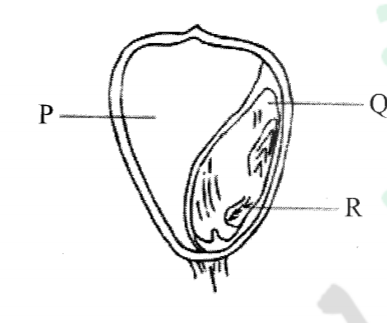
Which one of the following correctly identifies the parts labelled P, Q and R.
P Q R
A. Endosperm cotyledon radicle.
B. Endosperm cotyledon plumule.
C. Cotyledon endosperm plumule.
D. Cotyledon endosperm radicle.
43. Which one of the following groups only consists of planets in the 3rd. 5th and 8th position in the solar system‘?
A. Venus, Jupiter, Uranus.
B. Earth, Jupiter, Neptune.
C. Mercury, Mars, Saturn.
D. Venus. Uranus. Jupiter.
44. Which one of the following is an adaptation for both flying and swimming?
A. Strong hind legs.
B. Presence of wings.
C . Webbed feet.
D. Streamlined body.
45.The following are adaptations for feeding in herbivores. Which Info are for turning food in the mouth.
A. Presence of horny pad and continuously growing teeth.
B. Rough tongue and presence of diastema.
C. Presence of horny pad and rough tongue.
D. Continuously growing teeth and presence of diastema.
46. Which one of the following characteristics differentiates amphibians from reptiles?
A. Cold blooded.
B. Body covered with scales.
C. Partly live in water.
D. Lay eggs.
47. Which one of the following does not conserve energy?
A. Using a bicycle dynamo for lighting.
B. Using an improved jiko for cooling.
C. Using biogas for cooking.
D. Planting trees.
48. The diagram below shows a set-up prepared by a pupil to investigate an aspect of sound.
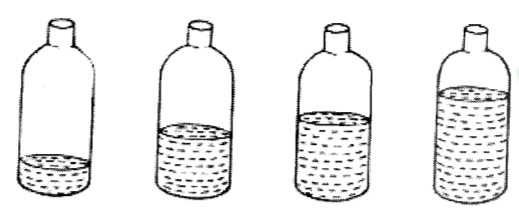
The aspect of sound investigated by the pupil is
A. production of sound by hitting.
B. sources of sound.
C. loud and soft sounds.
D. special sounds.
49. The diagram below shows a person riding a bicycle.
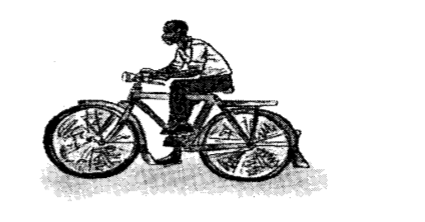
Which one of the following does not reduce friction during riding?
A. Leaning forward on the ride.
B. Treaded Tires.
C. Ball bearings in the wheels.
D. The shape of the wheels.
50. The diagram below shows some parasites labelled S, T, V and W.
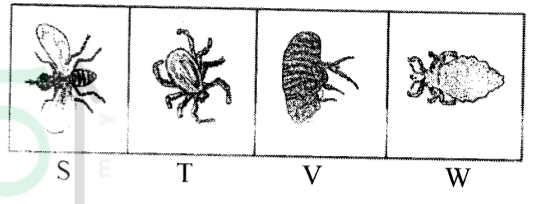
Which one of the parasites is more likely to reduce the quality of wool in sheep?
A. S
B. T
C. V
D. W
Questions and Answers
K.C.P.E 2019 Science
1. Which one of the following pairs of human body parts is used in breathing?
A. Lungs and oesophagus.
B.✔ Nose and trachea.
C. Diaphragm and stomach.
D. lose and oesophagus.
2. Which one of the following waste products is excreted by the lungs?
A. Excess salts.
B. Urine.
C. Sweat.
D.✔ Excess water.
3. Which one of the following pairs of diseases only consists of sexually transmitted infections?
A. Gonorrhoea and malaria.
B. HIV/AIDS and measles.
C.✔ Syphilis and chancroid.
D. Bilharzia and Gonorrhoea.
4. Which one of the following is the third stage of HIV/AIDS infections?
A.✔ Symptomatic.
B. Window.
C. Full blown.
D. Incubation.
5. Which one of the following components of the environment is the main source of energy for living things?
A. Plants.
B. Air.
C.✔ Water.
D. Soil.
6. Which one of the following least pollutes the soil?
A. Excess fertilisers.
B. Oil spillage.
C.✔ Kitchen leftovers.
D. Mining.
7. The soil that cracks easily when dry has
A. a rough texture.
B.✔ small particles.
C. large airspace.
D. low capillarity.
8. The diagram below shows a set-up used to investigate a certain component of soil.
The component of soil that was investigated is
A.✔ living organisms.
B. organic matter.
C. air.
D. water.
9. Which one of the following pairs of types of soil erosion forms V-shaped ditches?
A.✔ Gulley and rill.
B. Sheet and Gulley.
C. Rill $ Splash.
D. Splash and sheet.
10. Which one of the following nutritional deficiency diseases is more likely to be suffered by mothers or newly born babies?
A. Kwashiorko.
B. Marasmus.
C.✔ Anaemia.
D. Rickets.
11. Which one of the following foods is more rich in both proteins and fats‘.
A. Avocado.
B. Milk.
C.✔ Sunflower.
D. Beans.
12. The following produce special sounds, except sound from a?
A. hooting car.
B. fire engine.
C. ringing bell.
D.✔ moving tractor.
13.The diagram below shows a set-up that can be used to investigate heat transfer in a liquid. what should be added to the water for the pupils to observe heat transfer?
A.✔ Salt.
B. Stones.
C. Saw dust.
D. Wax.
14. In which of the following devices is renewable energy used?
A. Battery.
B. Kerosene stove.
C. Burning candle.
D.✔ Charcoal jiko.
15. The following activities were done when it was raining:
(i) walking bare footed on the road
(ii) lying on the bed
(iii) playing football in the field
(iv) driving a car on the road.
In which two activities is one more likely to be struck by lightning?
A. (i) walking bare footed on the road
B.(ii) lying on the bed
C.✔ (iii) playing football in the field
D. (iv) driving a car on the road.
16. Which one of the following sources of electricity pollutes air?
A. Dynamo.
B.✔ Geothermal generator.
C. Biogas driven generator.
D. Solar panel.
17. Which one of the following groups of materials consists only of materials that are magnetic?
A. Bottle top, copper coin, aluminium foil.
B.✔ Razor blade, staple pins. steel wool.
C. Spoon, copper wire, silx’er coin.
D. Nail, aluminium foil, silver coin.
18. The chart below represents a simple classification of liquids.
Which liquids are represented by E and F?
A. Kerosene , Water
B. Water , Milk
C. Cooking oil , Milk
D.✔ Water , Kerosene
19. Which one of the following materials allows light to pass through but one cannot‘see through?
A.✔ Fluorescent tube.
B. Smoke.
C. Clean water.
D. Mirror.
20. The percentage of the component of air that makes a bulb glow without burning is?
A. 75%
B. 21%
C. 0.03%
D.✔ 0.97%.
21. Which one of the following groups of substances has definite volume and shape?
A. Oxygen, water and ice.
B. Ink. grease, glucose.
C.✔ flour, powdered chalk, salt.
D. Sand, powdered milk, methylated spirit.
22. Which one of the following machines works in the same way as a croat bar?
A. Spade.
B.✔ Claw hammer.
C. Ladder.
D. Wheel barrow.
23.The following machine make work easier by reducing the effort required except
A. crowbar.
B. ramp.
C.✔ flag post.
D. ladder.
24. Which one of the following statements is true about rain water?
A. Uses more soap during washing.
B.✔ Saves time and energy during washing.
C. Is rich in minerals.
D. Stains clothes.
25. A pupil who buys mango fruits from market and eats without washing is likely to be infected with.
A.✔ typhoid and cholera
B. bilharzia and cholera
C. typhoid and malaria
D. bilharzia and malaria.
26.Which of the following practices conserves water by using it sparingly?
A. Treating and using sewage water.
B. Harvesting rain water.
C.✔ Using water used to wash vegetables to water plants.
D. Supplying water once a week.
27. Which of the following groups of activities only consists of industrial uses of water?
A. Fishing, transport, mixing chemicals.
B. Washing vehicles, constructing roads, mixing chemicals.
C. Boat racing, swimming, fishing.
D.✔ Cooling machines, drinking, cleaning of tools.
28. Which one of the following pairs of blood vessels carries deoxygenated blood?
A. Vena cava and aorta.
B. Pulmonary artery and pulmonary vein.
C.✔ Vena cava and pulmonary artery.
D. Pulmonary i min and aorta.
29. Which one of the following features is least important o hen describing a molar tooth‘?
A. Roots.
B. Cusps.
C. Broadness.
D.✔ Hardness.
30. Which one of the following components of blood is correctly matched to its function?
Blood component Function
A. Plasma Transports oxygen.
B. White blood cells heat distribution.
C.✔ Platelets Blood clotting.
D. Red blood cell Transports iron.
31. The following are some effects of drug abuse:
(i) drug induced accidents
(ii) addiction
(iii) coma
(iv) rape
(v) truancy
(vi) impaired judgement.
Which three are classified as health effects?
A. (i) (ii) (iv)
B (iii) (iv), (v).
C. ✔(ii), (iii), (vi).
D. (i), (iii), (iv).
32.The following are some characteristics of a certain vertebrate:
(i) scales on the body
(ii) varying body temperatures
(iii) lay externally fertilised eggs
The animal with the above characteristics is likely to be
A.✔ salamander.
B. shark.
C. lizard.
D. duck.
33. Which one of the following is the main effect of HIV/AIDS on the nation’?
A. Increased medical expenses.
B.✔ Poor health.
C. Stigmatisation.
D. Lack of parental care.
34. Which of the following statements is true about the immunisation schedule of infants’?
A. DPT vaccine is given at birth and the 6th week.
B. BCG and polio vaccines are given at birth and the 6th week.
C. DPT and measles vaccine are biven at 10 week.
D.✔ Polio and DPT vaccines are given at the 6th week.
35. The best way of preventing the spread of HIV/AIDS among the youths in Kenya is?.
A. seeking medication.
B. being faithful to their partners.
C.✔ abstinence.
D. testing and counselling.
36. Which one of the following plants is classified as both green and non flowering?
A. Mosses.
B. Sugarcane.
C.✔ Grass.
D. Mushroom.
37. A pupil classified drugs as shown below.

Which drugs were correctly classified by the pupil?
A.✔ Miraa and bhang.
B. Tobacco and mandrax.
C. Cocaine and miraa.
D. Bhang and alcohol.
38. Which one of the following pairs of crop pests is likely to attack a crop of maize growing in the field?
A. Weevils and aphids.
B. Cutworms and rodents.
C.✔ Weaver birds and rodents.
D. Weaver birds and cutworms.
39. A plant with deep and widespread root system is also likely to have?
A. Many Stomata.
B. Flexible Stomata.
C.✔ thick cuticles.
D. thin cuticles.
40. Which one of the following weeds cannot be effectively controlled by uprooting‘?
A. Mexican marigold.
B. Oxalis.
C. Wandering jew.
D.✔ Black jack.
41. The following are characteristics of a certain type of cloud except?
A. appears high in the skin.
B. indicates fine weather.
C.✔ is dark grey in colour.
D. has a flat base.
42. The diagram below shows a cross section of a maize grain.

Which one of the following correctly identifies the parts labelled P, Q and R.
P Q R
A.✔ Endosperm cotyledon radicle.
B. Endosperm cotyledon plumule.
C. Cotyledon endosperm plumule.
D. Cotyledon endosperm radicle.
43. Which one of the following groups only consists of planets in the 3rd. 5th and 8th position in the solar system‘?
A. Venus, Jupiter, Uranus.
B.✔ Earth, Jupiter, Neptune.
C. Mercury, Mars, Saturn.
D. Venus. Uranus. Jupiter.
44. Which one of the following is an adaptation for both flying and swimming?
A. Strong hind legs.
B. Presence of wings.
C . Webbed feet.
D.✔ Streamlined body.
45.The following are adaptations for feeding in herbivores. Which Info are for turning food in the mouth.
A. Presence of horny pad and continuously growing teeth.
B. Rough tongue and presence of diastema.
C.✔ Presence of horny pad and rough tongue.
D. Continuously growing teeth and presence of diastema.
46. Which one of the following characteristics differentiates amphibians from reptiles?
A. Cold blooded.
B. Body covered with scales.
C.✔ Partly live in water.
D. Lay eggs.
47. Which one of the following does not conserve energy?
A.✔ Using a bicycle dynamo for lighting.
B. Using an improved jiko for cooling.
C. Using biogas for cooking.
D. Planting trees.
48. The diagram below shows a set-up prepared by a pupil to investigate an aspect of sound.

The aspect of sound investigated by the pupil is
A. production of sound by hitting.
B. sources of sound.
C.✔ loud and soft sounds.
D. special sounds.
49. The diagram below shows a person riding a bicycle.

Which one of the following does not reduce friction during riding?
A.✔ Leaning forward on the ride.
B. Treaded Tires.
C. Ball bearings in the wheels.
D. The shape of the wheels.
50. The diagram below shows some parasites labelled S, T, V and W.

Which one of the parasites is more likely to reduce the quality of wool in sheep?
A. S
B. T
C. V
D.✔ W


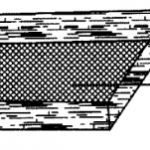
It’s a very beneficial platform,,
Asears
Excellent
Thanks for letting us know about the next steps in the process
100/100 💯💯 Respect